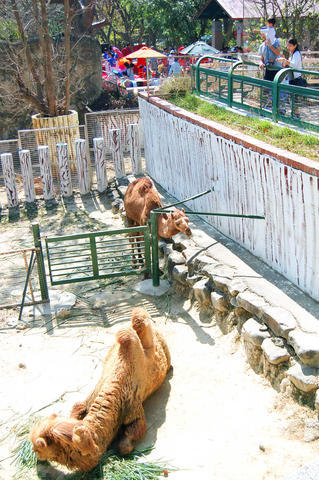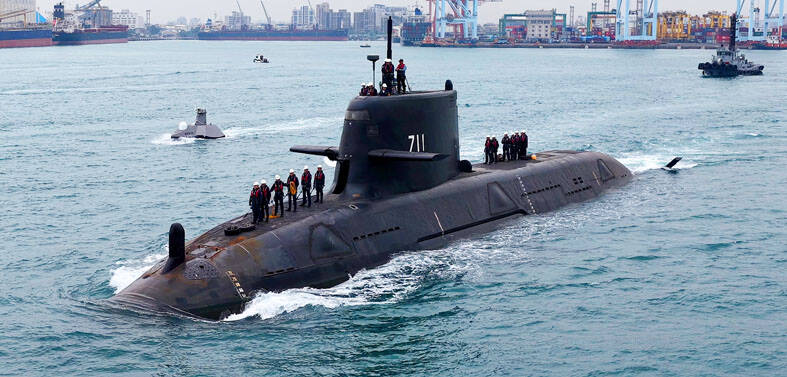Shoushan Zoo in Kaohsiung has made national news at least four times this year, all in a negative light.
In February, a chimpanzee bit off part of a three-year-old boy's finger while his father was holding him close to the animal. Two month's later, the zoo shocked the nation -- and subsequently drew international attention -- when a veterinarian had his forearm bitten off by a crocodile while he was trying to treat the sick animal. It was later learned that the vet mistakenly shot the crocodile with antibiotic darts instead of tranquilizers.
But, that wasn't the end of the tale.

PHOTO: HOU CHENG-HSU, TAIPEI TIMES
After learning the zoo identified the animal as a Nile crocodile during media coverage, a crocodile breeder in Tainan said the zoo's identification of the animal was incorrect.
report
After a report on Pingtung Technology University's Wild Animal Information Web site, the zoo admitted its mistake by confirming the animal was in fact a salt-water crocodile.
Later that month, the zoo admitted that an elephant named Ali was indeed a female after previously telling the public it was a male.
Ali had been married to a female elephant named Annie in a wedding ceremony staged by the zoo five years ago. The zoo argued that the wedding was held to attract tourists.
Earlier this week, the zoo admitted it did not realize a pair of its newly-arriving raccoons had escaped in March until workers discovered a huge hole next to the racoon enclosure.
inconvenient truth
These incidents, at times humorous, expose an inconvenient truth about the government-run zoo which the Kaohsiung City government must deal with.
Founded in 1978 in Kaohsiung's Sitzyywan (西子灣), the zoo was relocated to its current location at Shoushan (
Visits to the Shoushan Zoo may be one of the most common childhood memories shared by the majority of Kaohsiung residents.
The Shoushan Zoo, regarded as the major public zoo in southern Taiwan, did not, however, prosper like its counterpart in Taipei during the past three decades.
Jason Hung (洪富峰), director of Kaohsiung City's Economic Affairs Bureau, the authorities overseeing the zoo, said problems have arisen from a lack of manpower and a funding shortage.
budget
The budget Shoushan Zoo receives every year is disproportionate to that received by Taipei City's Muzha Zoo annually.
Records from the Kaohsiung City Council in 2005 show that the Shoushan Zoo's budget that year was about NT$14 million (US$426,000) while the Muzha Zoo received NT$440 million from the Taipei City Council.
According to Hung, Shoushan Zoo is greatly understaffed, with only 33 zoo staffers, three of whom are veterinarians, who are responsible for taking care of 500 to 600 animals of 80 species.
Kurtis Pei (裴家騏), a professor at the Institute of Wildlife Conservation of National Pingtung University of Science and Technology, said the fundamental problem with the zoo is the rationale behind its management.
`show business'
Over the past three decades, the city government has run the zoo as like "show business," focusing on a variety of animals and presenting them to the public in a "window display" model, Pei said.
Using this rationale, the zoo has neither cultivated professional zoo staffers nor attended to the welfare of its animals, he said.
"Zoos such as the San Diego Zoo and the Bronx Zoo in New York have no longer see building an animal collection as one of their objectives," Pei said. "Zoos now emphasize biological variety, while conserving animal genes and promoting the public's awareness of preserving those beings."
"Therefore, people can see not only animals but also how they live, which may further stimulate thought concerning the meaning of the animals' lives," he said.
The Kaohsiung City Government was aware of the problems with Shoushan Zoo, particularly after the series of mishaps and blunders that happened to the zoo this year.
Hung said he had ordered a thorough examination of the number and species of zoo animals following the city government's request in late April.
The city government has also instructed its economic affairs bureau to come up with a plan to transform the zoo.
options
There are three options in the plan, according to Pei.
The first is to shut down the zoo.
The second is to turn the zoo into an amusement park.
And the third is to turn the zoo into an open-air petting zoo.
The president of the Environment and Animal Society of Taiwan, Chu Tseng-hong (朱增宏), who has attended two meetings with the bureau since April, said his group's hope is to transform the zoo into a fenceless natural park inhabited by local animals only.
To reach that goal, Chu urged the zoo to stop breeding and importing new animals.
Pei, who also provides consultation to the bureau, said turning Shoushan Zoo into a fenceless zoo for cute animals is out of the question because he does not think the zoo is able to meet the high standard of staffers such a zoo requires.
"[The zoo] can't even get its visitors to behave when they are separated from the animals by enclosures," Pei said. "If it became a petting zoo, I can imagine tortoises being ridden by kids."
cost
Pei said improving animal living space is expected to cost NT$200 million to NT$300 million, but the economic affairs bureau has promised to fight for the funds.
"I don't care whether you want to close the zoo or turn it into something else, but in the next 20 years, you have to treat your animals well," he said. "In the next five to six years, the zoo needs to improve its animal care and living spaces. And within 10 years, it has to improve its manpower while helping the current staffers identify with the zoo."

SHIPS, TRAINS AND AUTOMOBILES: The ministry has announced changes to varied transportation industries taking effect soon, with a number of effects for passengers Beginning next month, the post office is canceling signature upon delivery and written inquiry services for international registered small packets in accordance with the new policy of the Universal Postal Union, the Ministry of Transportation and Communications said yesterday. The new policy does not apply to packets that are to be delivered to China, the ministry said. Senders of international registered small packets would receive a NT$10 rebate on postage if the packets are sent from Jan. 1 to March 31, it added. The ministry said that three other policies are also scheduled to take effect next month. International cruise ship operators

NUMBERS IMBALANCE: More than 4 million Taiwanese have visited China this year, while only about half a million Chinese have visited here Beijing has yet to respond to Taiwan’s requests for negotiation over matters related to the recovery of cross-strait tourism, the Tourism Administration said yesterday. Taiwan’s tourism authority issued the statement after Chinese-language daily the China Times reported yesterday that the government’s policy of banning group tours to China does not stop Taiwanese from visiting the country. As of October, more than 4.2 million had traveled to China this year, exceeding last year. Beijing estimated the number of Taiwanese tourists in China could reach 4.5 million this year. By contrast, only 500,000 Chinese tourists are expected in Taiwan, the report said. The report

Temperatures are forecast to drop steadily as a continental cold air mass moves across Taiwan, with some areas also likely to see heavy rainfall, the Central Weather Administration (CWA) said. From today through early tomorrow, a cold air mass would keep temperatures low across central and northern Taiwan, and the eastern half of Taiwan proper, with isolated brief showers forecast along Keelung’s north coast, Taipei and New Taipei City’s mountainous areas and eastern Taiwan, it said. Lows of 11°C to 15°C are forecast in central and northern Taiwan, Yilan County, and the outlying Kinmen and Lienchiang (Matsu) counties, and 14°C to 17°C

STEERING FAILURE: The first boat of its class is experiencing teething issues as it readies for acceptance by the navy, according to a recent story about rudder failure The Hai Kun (海鯤), the nation’s first locally built submarine, allegedly suffered a total failure of stern hydraulic systems during the second round of sea acceptance trials on June 26, and sailors were forced to manually operate the X-rudder to turn the submarine and return to port, news Web site Mirror Daily reported yesterday. The report said that tugboats following the Hai Kun assisted the submarine in avoiding collisions with other ships due to the X-rudder malfunctioning. At the time of the report, the submarine had completed its trials and was scheduled to begin diving and surfacing tests in shallow areas. The X-rudder,